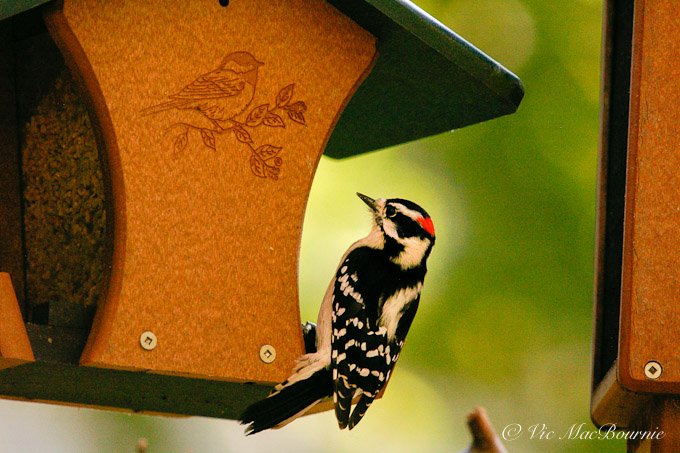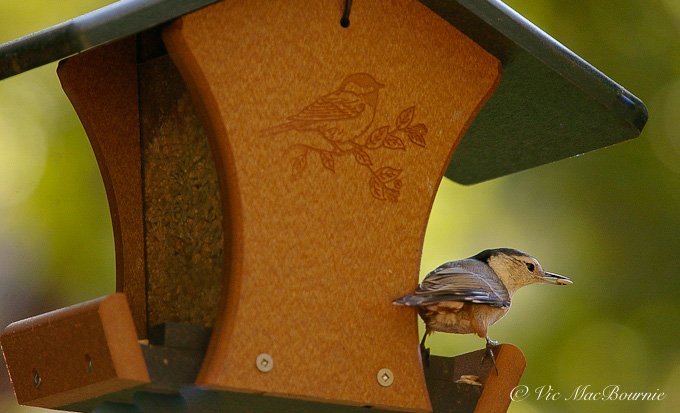What are the best bird feeders: Wood or more modern plastic bird feeders?
Avian flu outbreak is good reason to move to modern resin-based or plastic feeders
I love wood as much as the next guy, but when it comes to bird feeders, today’s more modern resin/plastic bird feeders are always the better choice.
The new plastic or resin-based feeders are easier to clean and keep clean and that helps to reduce the spread of disease among our songbirds.
This is especially important now with the emergence of Avian flu, which can be devastating to large flocks of birds that come in contact with the virus. It struck earlier this year in parts of the United States with primarily waterfowl and migrated north to northern states and into Canada. It was detected in Ontario in March of this year entering from migrating birds.
According to Cornell University’s All About Birds website: There is currently very low risk of an outbreak among wild songbirds, and no official recommendation to take down feeders unless you also keep domestic poultry, according to the National Wildlife Disease Program. We do always recommend that you clean bird feeders and birdbaths regularly as a way to keep many kinds of diseases at bay. We also always recommend that you follow any recommendations put out by your state government, such as the recent request to take down feeders in Illinois.”
Cornell reports that as of mid July, 2022, “they’ve detected the HPAI strain in 1,826 wild birds, with 41 detections in songbirds.
The website also reports that “Songbirds are much less likely than waterfowl to contract avian influenza and less likely to shed large amounts of virus, meaning they do not transmit the disease easily.”
The CDC reports the following: “Infected birds can shed avian influenza A viruses in their saliva, nasal secretions, and feces. Susceptible birds become infected when they have contact with the virus as it is shed by infected birds. They also can become infected through contact with surfaces that are contaminated with virus from infected birds.”
What can we do to reduce the spread of Avian Flu?
I have seriously reduced the amount of feed I use this year, preferring to put out just a little of the no-mess blend on a daily basis. This eliminates seed build-up and keeps the number of birds at the feeding station down considerably.
For more on purchasing these bird feeders on a budget check out my best bird feeder finds.
Having plastic or resin bird feeders is no guarantee that your backyard birds will escape the deadly virus, but plastic feeders are easier to keep clean and should help keep the birds at your feeder safe. Regular cleaning of the resin feeders is quick and easy. A quick wipe with bleach gets the job done and this will not damage the resins.
In fact, a quick look at the Wild Birds Unlimited website shows 12 eco-friendly (resin) hopper bird feeders and only a single wood hopper feeder. I’m sure more are available in-store, but there is no question that the eco-friendly recycled plastic feeders are proving popular despite their high price tag.
Wild Birds Unlimited is not the only location where you can purchase high-quality, plastic feeders. If you are looking for a stylish addition to your garden, Look no further than Garret Wade’s impressive line of feeders. Their church-style-bird feeder is currently on clearance and would be a good choice as both a high quality bird feeder and piece of garden art.
Wild Birds Unlimited is a leader in the industry when it comes to backyard bird feeding. They describe their EcoTough Classic hopper-style feeder as a high quality feeder that “won’t crack, fade or rot. EcoTough® feeders are environmentally friendly, high quality products made from recycled plastic milk jugs. … Perch drains allow seed to drop out of the feeder for ground-feeding birds to eat, and angled perches let empty seed hulls be blown away by the wind. The removable screen bottom is treated with EcoClean® Product Protection, providing 24/7 product protection.”
Amish-made bird feeder is built to last and perform in your woodland garden
The Amish crafted large gazebo vinyl birdfeeder is the perfect addition to any backyard. Include it as a finishing touch topping feeder for your bird feeding pole, or use it as a stand alone feeder on a separate pole. If you use it as a stand alone feeder, be sure to include a squirrel baffle to keep squirrels and racoons of the feeder. This handmade and handcrafted feeder includes a clear plastic, built-in seed storage container that can hold up to four pounds of bird seed.
This makes it an ideal feeder to fill-and-forget for a week or two while, at the same time, protecting the seed from the elements and providing our feathered friends with a comfortable and sheltered place to feed. The fact that the feeder is made from high quality vinyl, plastic and cedar ensures it is a long-lasting, easy-to-clean and maintain feeder.
If you are looking to set up a bird-feeding station, be sure to check out my post on Setting Up a Bird Feeding Pole.
At our feeding station, plastic, or more appropriately resin, certainly takes centre stage. All wood products have been replaced with resin ones including two WBU hopper-style feeders, a catch tray that doubles as a platform feeder and a suet feeder for our woodpeckers.
The resin feeders, although expensive, are extremely well-built and will likely last a lifetime if treated and cared for properly. Using a jet of water from the hose or even a power washer is not likely to damage these sturdy feeders and will clean out any food that might have built up. Wooden feeders eventually break down and, for the most part, are unable to withstand many power washings.
Any other feeders in our yard are either steel or a combination of steel and plastic.
The only feeder with wood is a small, stylish copper and cedar feeder that is kept separate from the main feeding area and is filled once a day with only a handful of safflower seeds.
In addition to the array of resin hopper feeders available at Wild Birds Unlimited, there are also resin bark butter feeders, and a series of rustic feeders.
Similar plastic feeders are available at other specialty bird stores as well as more affordable versions at Amazon with, for example, the Woodlink Premier Bird Feeder with suet cages and the Birds Choice Hopper Feeder in medium green.
These feeders are built to withstand everything our friendly squirrels can throw at them and keep performing at their best.
If you are thinking about creating a bird feeding station, investing in a single recycled plastic hopper feeder is an excellent choice. Over time, you can add additional feeders and build a high quality bird-feeding station that is easy to keep clean and will last a lifetime, while providing the birds with well thought out feeders that will help to keep them safe.




